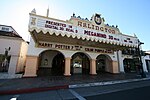National Center for Ecological Analysis and Synthesis
The National Center for Ecological Analysis and Synthesis (NCEAS) is a research center at the University of California, Santa Barbara, in Santa Barbara, California. Better known by its acronym, NCEAS (pronounced “n-seas”) opened in May 1995. Funding for NCEAS is diverse and includes supporters such as the U.S. National Science Foundation, the State of California, and the University of California, Santa Barbara. NCEAS supports cross-disciplinary research that analyzes and synthesizes existing data to address major fundamental issues in ecology and allied fields, and encourages the application of science to natural resource management and public policy decision making. To facilitate synthetic analysis, NCEAS advances new techniques in mathematical and geospatial modeling, dynamic simulation, and visualization of ecological systems through its Ecoinformatics program. Since its inception, the Center has hosted over 5,000 individuals and supported roughly 500 research projects, which have resulted in more than 2,000 publications in 300+ different journals. In addition, NCEAS engages graduate students and grade school children through a variety of outreach and education programs.
Excerpt from the Wikipedia article National Center for Ecological Analysis and Synthesis (License: CC BY-SA 3.0, Authors).National Center for Ecological Analysis and Synthesis
State Street, Santa Barbara
Geographical coordinates (GPS) Address Nearby Places Show on map
Geographical coordinates (GPS)
| Latitude | Longitude |
|---|---|
| N 34.4192 ° | E -119.69937 ° |
Address
Balboa Building
State Street 735
93101 Santa Barbara
California, United States
Open on Google Maps








